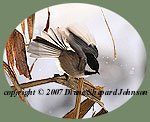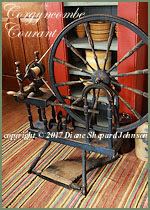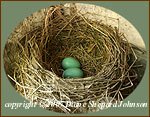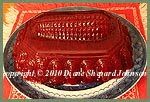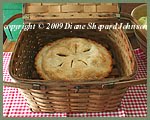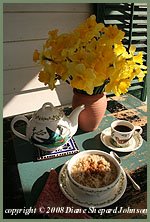
Dandelions fill the days of May, first with sunny yellow! How pretty they are on the lawn when they first flower, yellow and short. As the flowers turn to seed, the dandelions are topped with a round ball of white fluff.
What fun it is to blow the dandelions when they go to seed and turn white and then to see the fluff flitter, flutter about!
It, however, doesn't take very long, as dandelions grow like weeds, before they are tall, the seeds are blown away, and the stems are tough. At Corgyncombe they can grow two feet tall!
The chosen music to accompany this post is Arabesque by Debussy:
Click Here for Specially Chosen Musical Entertainments.
Return Here to Read the Corgyncombe Courant.
The music is so delightful whilst reading!
 In the story "Dandelion Clocks", written by Juliana Horatia Ewing, the children blow the dandelion seeds in a sort of amusement, a game to make a determination as to the time. As Juliana Horatia Ewing wrote "You blow till the seed is all blown away, and you count each of the puffs - an hour to a puff."
In the story "Dandelion Clocks", written by Juliana Horatia Ewing, the children blow the dandelion seeds in a sort of amusement, a game to make a determination as to the time. As Juliana Horatia Ewing wrote "You blow till the seed is all blown away, and you count each of the puffs - an hour to a puff."
 In the story, Little Peter Paul was perplexed as to why one child's time was so different from the other. He was quite the literal thinker and knew that each person had the same amount of hours each day. His sisters thought that dandelion clocks told "fairy time". When you blow on the dandelion seeds they do give a twinkly, fairy-like appearance. When Peter grew up he went out to sea, where he traveled a great deal and enjoyed the life of a sailor. When he came back to his sisters and the farm for a lengthy visit, time stood still and hours dragged and he could barely wait for the time to be over until he could return to the sea.
In the story, Little Peter Paul was perplexed as to why one child's time was so different from the other. He was quite the literal thinker and knew that each person had the same amount of hours each day. His sisters thought that dandelion clocks told "fairy time". When you blow on the dandelion seeds they do give a twinkly, fairy-like appearance. When Peter grew up he went out to sea, where he traveled a great deal and enjoyed the life of a sailor. When he came back to his sisters and the farm for a lengthy visit, time stood still and hours dragged and he could barely wait for the time to be over until he could return to the sea.
Hours sometimes seem to go faster or slower for different people, depending on how dull or interesting things are to them.
 "Dandelion Clocks" illustrated by Gordon Browne.
"Dandelion Clocks" illustrated by Gordon Browne.
In the 1981 version of Robert Louis Stevenson's "A Child's Garden of Verses", illustrated by Tasha Tudor, on the next page after the title page, is an illustration of a little girl telling time by blowing dandelion clocks, which is very similar to the illustration of the little girl on the left, done by Gordon Browne.
Under Tasha Tudor's illustration is the quote:
"To me, fair friend, you never can be old,
For as you were when first your eye I ey'd,
Such seems your beauty still."
Shakespeare's Sonnet CIV
 A drawing from the Corgyncombe Art Collection,
A drawing from the Corgyncombe Art Collection,
children telling time with dandelion clocks.

 The goats at pasture, amongst the dandelions.
The goats at pasture, amongst the dandelions.
When I think of May and dandelions, I remember my neighbor Marika who made the best dandelion wine. She gave me the receipt for making it. Marika was a few years younger than my grandmum and was of European heritage. Oft' times we would go over to Marika's house for an evening and discuss knitting and crocheting, baking, and gardening. Usually the evening would be topped off with a glass of her homemade wine. Marika's husband, who was also of Old World ancestry, always walked us safely home to our door. Not that we were tipsy, mind you, he was just being a gentleman.
During the spring and summer Marika usually had something fermenting in a large crock.
Marika lived in the most wonderful old house with a marvelous wing on the back that had an old summer kitchen that held an old beauty of a black cast iron wood cookstove. Marika did the finishing off of her maple syrup on that cookstove.
Marika's kitchen cupboards, instead of having doors, had curtains of old fashioned material. She was a wonderful artist and her paintings covered her walls.
Marika loved to garden and she had vegetable gardens and flower gardens. I especially loved the outside area around and about the old ell (the part that housed the old summer kitchen) off the back of the house. It was so charming and pleasant there with flowers round.
Marika's husband was in charge of lawn mowing. Marika liked to transplant some of her flowers to unusual and unlikely places about the lawn and we could always tell, clear over at our house, when he, uhh, accidentally ran her plants down. You could frequently hear her bellowing his full name, all the way over to our house, and "You just ran down my ...."
 A hand coloured plate with dandelions in the antique book
A hand coloured plate with dandelions in the antique book
"New Cyclopaedia of Botany and Complete Book of Herbs".
Every Christmas Marika would make a delicious pastry called potica.
She would put a cloth down on her huge table and work the potica dough very, very thin to cover most of the table. A delicious mixture of milk, honey and sugar were heated to a boil and, with the addition of nuts, cinnamon, and other good things, the mixture was spread on top of the dough. The dough was then rolled up, like a jelly roll, so that it had many layers with the delicious goodness in between. This was cut into sections and baked.
When you visited Marika she always sent you home with something, such as seeds, plant cuttings, old issues of her Workbasket magazine, frames for making pompoms, a fork for making hairpin lace, a couple of kittens, and a purgative herbal mixture to eradicate hairballs from cats.
Does this not bring to mind, in Mrs. Gaskell's "Cranford", when the kitty swallowed the favoured lace which had to be brought up with a purgative?
It was always so interesting and fun to go visit clever Marika. Her house and grounds were so full of charm and beauty and had so much personality!
Alas, Marika is gone now, her house bears little resemblance to the quaint old place it used to be. The old wing has been taken off, the summer kitchen is no longer there, it has been replaced with another modern wing, just so dull inside and out, compared to the place where I pleasantly spent many the hour!
 An old calendar from the Corgyncombe Ephemera Collection, featuring Dandelions for the month of May and the poem by James Russell Lowell:
An old calendar from the Corgyncombe Ephemera Collection, featuring Dandelions for the month of May and the poem by James Russell Lowell:
"Dear common flower, that grow'st
beside the way -
First pledge of
blithesome May"
http://corgyncombecourant.blogspot.com/2012/05/dandelion-clocks.html
copyright © 2012 Diane Shepard Johnson and Sarah E. Johnson
~~~~~~~~~~~~~~~~~~~~~~~~~~~~~~~~
What fun it is to blow the dandelions when they go to seed and turn white and then to see the fluff flitter, flutter about!
It, however, doesn't take very long, as dandelions grow like weeds, before they are tall, the seeds are blown away, and the stems are tough. At Corgyncombe they can grow two feet tall!
The chosen music to accompany this post is Arabesque by Debussy:
Click Here for Specially Chosen Musical Entertainments.
Return Here to Read the Corgyncombe Courant.
The music is so delightful whilst reading!
 In the story "Dandelion Clocks", written by Juliana Horatia Ewing, the children blow the dandelion seeds in a sort of amusement, a game to make a determination as to the time. As Juliana Horatia Ewing wrote "You blow till the seed is all blown away, and you count each of the puffs - an hour to a puff."
In the story "Dandelion Clocks", written by Juliana Horatia Ewing, the children blow the dandelion seeds in a sort of amusement, a game to make a determination as to the time. As Juliana Horatia Ewing wrote "You blow till the seed is all blown away, and you count each of the puffs - an hour to a puff." In the story, Little Peter Paul was perplexed as to why one child's time was so different from the other. He was quite the literal thinker and knew that each person had the same amount of hours each day. His sisters thought that dandelion clocks told "fairy time". When you blow on the dandelion seeds they do give a twinkly, fairy-like appearance. When Peter grew up he went out to sea, where he traveled a great deal and enjoyed the life of a sailor. When he came back to his sisters and the farm for a lengthy visit, time stood still and hours dragged and he could barely wait for the time to be over until he could return to the sea.
In the story, Little Peter Paul was perplexed as to why one child's time was so different from the other. He was quite the literal thinker and knew that each person had the same amount of hours each day. His sisters thought that dandelion clocks told "fairy time". When you blow on the dandelion seeds they do give a twinkly, fairy-like appearance. When Peter grew up he went out to sea, where he traveled a great deal and enjoyed the life of a sailor. When he came back to his sisters and the farm for a lengthy visit, time stood still and hours dragged and he could barely wait for the time to be over until he could return to the sea.Hours sometimes seem to go faster or slower for different people, depending on how dull or interesting things are to them.
 "Dandelion Clocks" illustrated by Gordon Browne.
"Dandelion Clocks" illustrated by Gordon Browne.In the 1981 version of Robert Louis Stevenson's "A Child's Garden of Verses", illustrated by Tasha Tudor, on the next page after the title page, is an illustration of a little girl telling time by blowing dandelion clocks, which is very similar to the illustration of the little girl on the left, done by Gordon Browne.
Under Tasha Tudor's illustration is the quote:
"To me, fair friend, you never can be old,
For as you were when first your eye I ey'd,
Such seems your beauty still."
Shakespeare's Sonnet CIV
 A drawing from the Corgyncombe Art Collection,
A drawing from the Corgyncombe Art Collection,children telling time with dandelion clocks.

 The goats at pasture, amongst the dandelions.
The goats at pasture, amongst the dandelions.When I think of May and dandelions, I remember my neighbor Marika who made the best dandelion wine. She gave me the receipt for making it. Marika was a few years younger than my grandmum and was of European heritage. Oft' times we would go over to Marika's house for an evening and discuss knitting and crocheting, baking, and gardening. Usually the evening would be topped off with a glass of her homemade wine. Marika's husband, who was also of Old World ancestry, always walked us safely home to our door. Not that we were tipsy, mind you, he was just being a gentleman.
During the spring and summer Marika usually had something fermenting in a large crock.
Marika lived in the most wonderful old house with a marvelous wing on the back that had an old summer kitchen that held an old beauty of a black cast iron wood cookstove. Marika did the finishing off of her maple syrup on that cookstove.
Marika's kitchen cupboards, instead of having doors, had curtains of old fashioned material. She was a wonderful artist and her paintings covered her walls.
Marika loved to garden and she had vegetable gardens and flower gardens. I especially loved the outside area around and about the old ell (the part that housed the old summer kitchen) off the back of the house. It was so charming and pleasant there with flowers round.
Marika's husband was in charge of lawn mowing. Marika liked to transplant some of her flowers to unusual and unlikely places about the lawn and we could always tell, clear over at our house, when he, uhh, accidentally ran her plants down. You could frequently hear her bellowing his full name, all the way over to our house, and "You just ran down my ...."
 A hand coloured plate with dandelions in the antique book
A hand coloured plate with dandelions in the antique book"New Cyclopaedia of Botany and Complete Book of Herbs".
Every Christmas Marika would make a delicious pastry called potica.
She would put a cloth down on her huge table and work the potica dough very, very thin to cover most of the table. A delicious mixture of milk, honey and sugar were heated to a boil and, with the addition of nuts, cinnamon, and other good things, the mixture was spread on top of the dough. The dough was then rolled up, like a jelly roll, so that it had many layers with the delicious goodness in between. This was cut into sections and baked.
When you visited Marika she always sent you home with something, such as seeds, plant cuttings, old issues of her Workbasket magazine, frames for making pompoms, a fork for making hairpin lace, a couple of kittens, and a purgative herbal mixture to eradicate hairballs from cats.
Does this not bring to mind, in Mrs. Gaskell's "Cranford", when the kitty swallowed the favoured lace which had to be brought up with a purgative?
It was always so interesting and fun to go visit clever Marika. Her house and grounds were so full of charm and beauty and had so much personality!
Alas, Marika is gone now, her house bears little resemblance to the quaint old place it used to be. The old wing has been taken off, the summer kitchen is no longer there, it has been replaced with another modern wing, just so dull inside and out, compared to the place where I pleasantly spent many the hour!
 An old calendar from the Corgyncombe Ephemera Collection, featuring Dandelions for the month of May and the poem by James Russell Lowell:
An old calendar from the Corgyncombe Ephemera Collection, featuring Dandelions for the month of May and the poem by James Russell Lowell:"Dear common flower, that grow'st
beside the way -
First pledge of
blithesome May"
http://corgyncombecourant.blogspot.com/2012/05/dandelion-clocks.html
copyright © 2012 Diane Shepard Johnson and Sarah E. Johnson
~~~~~~~~~~~~~~~~~~~~~~~~~~~~~~~~

